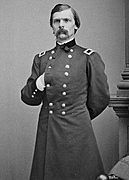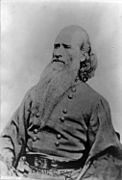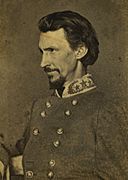Expedition to Pass Manchac and Ponchatoula facts for kids
Quick facts for kids Expedition to Pass Manchac and Ponchatoula |
|||||||
|---|---|---|---|---|---|---|---|
| Part of the American Civil War | |||||||
 |
|||||||
|
|||||||
| Belligerents | |||||||
| Commanders and leaders | |||||||
| Benjamin F. Butler George C. Strong Abner Read |
Daniel Ruggles M. Jeff Thompson Allen R. Witt |
||||||
| Units involved | |||||||
| 13th Connecticut 12th Maine 26th Massachusetts |
10th Arkansas 9th Louisiana, Company D C.S.A. Home Guard |
||||||
| Strength | |||||||
| 900 USS New London Steamer Ceres |
1,500 6 Cannons |
||||||
| Casualties and losses | |||||||
| 16 killed 22 wounded 2 missing |
20 killed unknown wounded |
||||||
The Expedition to Pass Manchac and Ponchatoula was a military event during the American Civil War. It happened from September 13 to 15, 1862, near Pass Manchac and Ponchatoula, Louisiana. The main goal for the Union army was to destroy a key bridge. They also hoped to capture a Confederate general named M. Jeff Thompson. This would stop him from attacking New Orleans.
Union soldiers reached the town while under fire from Confederate troops. They managed to damage the Manchac railroad bridge. They also burned 20 train cars. The Union forces were able to overpower the Confederates at first. However, the Confederates soon got more soldiers. They attacked the Union troops, forcing them to retreat back to New Orleans.
Contents
Why This Battle Happened
Confederate Brig. Gen. M. Jeff Thompson was in charge at Ponchatoula. He was ordered to fix the railroad bridge in Pass Manchac. After the Capture of New Orleans by Union forces, Maj. Gen. Benjamin F. Butler learned about the bridge repairs. He worried that Confederate forces might use it to attack New Orleans.
So, General Butler came up with a plan. He ordered Maj. George C. Strong to destroy the railroad bridge. He also wanted Maj. Strong to capture General Thompson in Ponchatoula.
Union Forces and Leaders
The Union forces involved in this expedition included:
- 13th Connecticut Infantry Regiment
- 12th Maine Volunteer Infantry Regiment
- 26th Regiment Massachusetts Volunteer Infantry
- The ship USS New London
- The Steamer Ceres
| Union Commanders |
|---|
|
Confederate Forces and Leaders
The Confederate forces involved in this expedition included:
- 10th Arkansas Infantry Regiment
- 9th Louisiana, Company D
- Confederate Home Guard
- 6 Cannons
| Confederate Commanders |
|---|
|
|
General Butler's Battle Plan
General Butler planned a clever attack. He would send the USS New London with troops to Pass Manchac. At sunrise, these soldiers would destroy the Manchac railroad bridge. They would then push enemy soldiers north towards the town. This move was meant to draw the Confederates' attention south of Ponchatoula.
Meanwhile, a larger group of soldiers on the Steamer Ceres would sail east. They would go along the Tangipahoa River. Once they reached their spot, the Ceres troops would land. They would march six miles into town. Their goal was to surround the Confederates. They would capture the town and General Thompson. This plan aimed to trap the Confederate soldiers so they couldn't escape.
The Days Before the Battle
The Union soldiers started to plan their attack on Ponchatoula. On September 13, Captain Abner Read waited at Pontchartrain Wharf. He was waiting for the troops to cross the lake. Maj. George C. Strong and soldiers from the 12th Maine Volunteer Infantry Regiment and 26th Regiment Massachusetts Volunteer Infantry boarded the Steamer Ceres.
Before that, Maj. Strong ordered 100 men from the 13th Connecticut Infantry Regiment to board the USS New London. Captain Read was in command of this ship. However, sailing the USS New London to Manchac was hard. The ship struggled to cross a sandbar. There was only five feet of water, and it was dark. The Steamer Ceres also had trouble. The river was too narrow and winding for them to reach their planned landing spot. They tried for two nights but couldn't make it.
The Battle on September 15
After two failed attempts to get the ships into position, Maj. Strong changed the plan. On the morning of September 15, he ordered the Ceres to go to Manchac Bridge. The USS New London stayed anchored in the lake. When they landed, Strong ordered one company of the 12th Maine, led by Capt. Winter, to destroy the Manchac railroad bridge.
Strong then told Capt. Pickering's 26th Massachusetts Co. F to guard the Ceres. He and the other two companies of the 12th Maine started marching 10 miles towards Ponchatoula. The soldiers of the 13th Connecticut stayed with the USS New London. About 9 miles later, the two companies, around 125 men, got close to town. They saw a train heading to Camp Moore. The Union soldiers fired at the train. The train sped off, blowing its horn to warn the town about the approaching Union troops. The 12th Maine hurried towards the city before the train could reach the camp.
When they arrived in town, the 12th Maine faced heavy artillery fire. About 300 soldiers from the 10th Arkansas Infantry Regiment and local Confederate Home Guard attacked them. Capt. Thorton of the 12th Maine was hit by a cannonball. The 12th Maine took cover and spread out. One part went left, the other went right. The Confederate positions were overwhelmed by Union gunfire. Their artillery retreated into the woods, and the infantry followed.
After the Confederates retreated, the 12th Maine soldiers set fire to 20 train cars. These cars were carrying cotton, sugar, and molasses. They also destroyed the bridge over the Ponchatoula River. Finally, they took documents from the post office and telegraph office. They also destroyed the telegraph equipment. They didn't capture Brig. Gen. Thompson. But they did enter his hotel and took his sword, spurs, and bridle.
While the Union troops held the town, Brig. Gen. Daniel Ruggles heard about the attack. He asked Gen. Earl Van Dorn for more soldiers. About 1,000 more troops, likely from Camp Moore, arrived. These troops, led by Col. Allen R. Witt of the 10th Arkansas, pushed the Union soldiers back. They took back their artillery and started firing again. The 26th Massachusetts, who were guarding the Ceres, came up to help. They provided cover fire for the 12th Maine as they retreated. This stopped the Confederates from surrounding them. The Union troops had to leave some of their wounded behind. These wounded soldiers, along with doctors, became prisoners in the town hospital.
One soldier, Private Elmore Dane of the 26th Massachusetts, described the difficult retreat. He noted that many men were lost. He said his company helped save the others from being captured. They covered their friends as they pulled back. It was a tough fight, and they had to leave some of their injured behind.
What Happened After the Battle
After the Union troops retreated, the Confederates took back Ponchatoula. Even though the Union didn't hold the town, they did succeed in destroying important things. They destroyed the Manchac railroad bridge, a bridge over the Ponchatoula River, the telegraph equipment, and 20 train cars.
The Union lost 16 soldiers, had 22 wounded, and 2 went missing. The Confederates lost about 20 soldiers, and many were wounded. Six months later, the new Union commander, Gen. Nathaniel Banks, heard a rumor. He heard that Gen. Stonewall Jackson might arrive at Camp Moore with over 30,000 men. Fearing another attack on New Orleans, General Banks planned another expedition to Ponchatoula. His goal was to destroy the railways so Confederates couldn't use them. This later event became known as the Battle of Ponchatoula.
Images for kids









